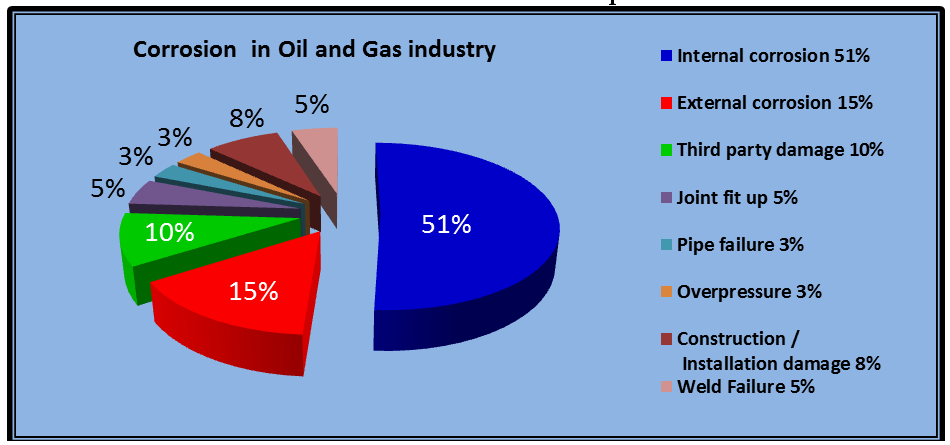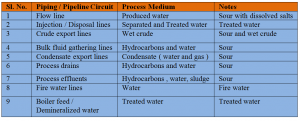March 2012, Vol. 239 No. 3
Features
Avoiding Internal Corrosion With Glass-reinforced Plastic

Millions of dollars are spent annually to maintain hydrocarbon pipelines free from any operational breakdowns. In most cases of such breakdowns, the cause is internal corrosion (Figure 1).
New, economically attractive corrosion-resistant material options are being explored by operating companies to lower expenditures for pipeline maintenance activities, reduce the incidence of breakdowns and ensure trouble-free operations .
One of the most favored alternate materials of construction is glass-reinforced plastics (GRPs), a nonmetal. Though GRPs have found the way into the other sectors like municipal water supply, sewage treatment, firefighting systems, etc., GRPs are yet to make it into the oil and gas sector. Excellent corrosion resistance combined with good strength has put GRPs on an unshakable position in the material and corrosion fraternities of other industries.
This article is an attempt to bring to the fore the salient features of GRPs with their advantages and limitations as pipeline material of construction in the oil and gas industry. The brief does not focus on other pipeline fittings like valves, flanges, tees etc., nor does it offer any specific recommendation on the subject which is beyond the scope of this article.
Glass-reinforced Plastics (GRPs) – The Material Mascot
GRPs is basically a nonmetallic thermosetting plastic with a combination of reinforcement fiber wound in a polymer. GRPs are commonly known by various names and standards as 1) Fiberglass Reinforced Plastics (FRPs), 2) Glass Reinforcement Plastics (GRPs), and 3) Reinforced Thermoset Resin Plastics (RTRPs). The ASTM standard defines GRP pipe as: “a tubular product containing glass fiber reinforcements embedded in or surrounded by cured thermosetting resin.”
There are a number of varieties of resins and fiber reinforcement materials used in the manufacturing of GRP line pipes. Glass fiber is the most favorable material used in more than 90% of all resin/filament GRP manufacturing today. The resins are of many types such as polyester resins, vinyl ester resins, bisphenol, phenolic resins and epoxy resins while reinforcements are E-Glass, S-Glass, Aramid, carbon/graphite etc. Some of the salient features of GRPs are indicated below:
1) Excellent corrosion resistance. The GRPs are practically immune and resistant to almost all types of chemicals, and fluids encountered in the oil and gas industry. The excellent corrosion resistance of GRPs to all types of hydrocarbon fluids makes it one of the most favored materials of construction in oil and gas industry.
2) Good material strength, with high strength to weight ratio. GRPs with good flexural strength have excellent mechanical strength and can withstand moderate-to-high pressures and any surge pressures during the operating life. Its high strength to weight ratio makes it easy to handle, transport during installation, construction phases. Another advantage with GRPs is that the resin and fiber can be selected suitably to maximize the service performance with respect to corrosion resistance to suit the specific application and operating envelope.
3) Flexibility in manufacturing. The biggest advantage of GRP is the flexibility in the manufacturing process to fabricate different sizes, lengths and configuration to suit the site construction and installation requirements saving sourcing and procurement headaches. Even smaller lengths of GRPs can be manufactured in continuous spoolable packs that facilitate transportation and installation much easy. With spoolable pipe the joints are minimized and installation over long distances is maximized effectively.
Benefits As Pipeline Material
The outstanding corrosion resistance of GRPs, combined with ease of construction and installation, strongly places GRPs in a better position than conventional steels as material of construction for the oil and gas industry. Though the capital spending is higher with GRPs, operating expenses are significantly lower in comparison to conventional materials such as steels. The benefits that accrue due to the use of GRPs are many-fold and some of them are highlighted here:
1) GRPs have excellent corrosion resistance to all types of corrosion phenomenon encountered in oil and gas industry- corrosion due to acid gases like CO2 corrosion (sweet), H2S corrosion (sour), pitting corrosion due to presence of oxygen, chlorides, and other dissolved salts, microbially induced corrosion etc. GRPs is practically maintenance-free.
2) GRPs in buried construction, being inert to any external corrosion such as soil corrosion and stray currents, does not need any additional protection like external coatings or cathodic protection as in case of steels. Even for aboveground lines GRPs does not require any external coating or paintings as part of mitigation for external atmospheric corrosion.
3) Due to the light weight of GRPs, heavy handling equipment is not required during construction and installation activities.
4) The smooth internal surfaces of GRPs prevent scale formation and settlement of bacterial colonies which can induce microbial corrosion.
5) The smooth internal surface of GRPs also reduces the frictional losses during fluid flow resulting in lower pumping energy consumption.
Limitations As Pipeline Material
Though GRPs has many advantages, the material is not a magical potion or cure for all the ills. Some of the limitations of GRPs as pipeline material are mentioned below:
1) One of the biggest drawbacks with GRPs is the environmental, chemical degradation or aging of the material as it approaches the end of design life. The consequence of aging is normally a reduction in flexural strength and chemical degradation (resin) micro cracks and delamination between the reinforcing fibers. The aging results in loss of strength, “weepage” through the thickness and makes the material vulnerable for failures.
2) Also, there is concern about assessing the health of the pipeline to validate the remaining life through NDT methods such as ultrasonic, electromagnetic or radiographic techniques. These methods are not fully developed or standardized as is the case with steel pipelines or their components. However, some of the international standards (NORSOK) have given fairly good information on these aspects.
3) Unfortunately, for GRPs only limited inspection procedures and techniques – such as visual and hydro testing – are now available to the industry. The challenging task facing the integrity or pipeline inspection personnel is the absence of any adequate and standard procedures and unfamiliar techniques associated with nonmetals like GRPs.
4) Many critical issues facing asset owners, the integrity staff and the operations staff involve the need to validate and assess the FFS – “Fitness–For–Service” – of the GRPs as it reaches the design life of the system.
5) Also, there are no standard methods or procedures to condition monitor or repair the material defects developed due to loadings and potential degradation mechanisms during the operating life of the pipeline.
6) Another disadvantage with the GRPs is the mechanical damage for the materials that can occur during storage, handling and installation. The pipe also can be damaged while burying and backfilling operation if proper care is not taken.
7) GRPs requires specially trained personnel for making the joint fit ups between the pipes and pipes and fittings. Following manufacturer’s recommendations, jointing procedures, sticking to required fitting tolerances are imperative practices to achieve a pressure-tight joint. Specialist guidance and specialist skills are required for the jointers and the supervisors involved in the construction and installation of a GRPs line pipe.
Application In The Industry
With all of the above constraints and limitations, GRPs still is a viable option for the corrosion headaches vis-à-vis steel pipelines. In the Middle East, GRPs is widely and successfully used in many oil and gas installations on-shore and off-shore. Some of the circuits where GRPs is used are indicated in Table 1.


Figure 2: Two views of GRP pipeline installation in progress.
GRPs is definitely an economic and viable optional replacement for conventional steels for some pipeline applications. However, GRPs may not be the material engineer’s paradise all the way. Proper review and analysis of the system need to be carried out regarding the application, construction, installation and operating and maintenance requirements and procedures before jumping onto the GRPs bandwagon in the oil and gas industry.
Author
K. Nalli is lead discipline consultant for the Corrosion and Materials discipline with Tebodin & Partners LLC, an engineering consultant in oil and gas industry in the Sultanate of Oman. He is a first-class graduate in mechanical engineering with post-graduate qualifications of M.Tech in welding metallurgy from the Indian Institute of Technology, Kharagpur, India. He can be reached at knalli@tebodin.co.om.
References
ASTM / NORSOK / UKOOA standards
Offshore conference proceedings 2009
Personal communications with various GRPs vendors





Comments